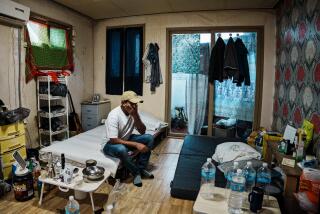Female veteran fights an invisible injury
The Bullfrog Brewery is crowded for lunch and tables are scarce, but former Army Sgt. Angel Harris finds one where she can sit with her back to a wall and still see out a window. She isn’t sure what she’s watching for. A sniper maybe, or an ambush.
This is downtown Williamsport — the Appalachian hamlet where Little League was born — not the sort of place where people wait around for something awful to happen. But that’s the way Harris has viewed the world since she returned from Afghanistan eight years ago carrying her unborn son and a case of PTSD.
The baby was easy to figure out. A home pregnancy test administered in a camp latrine saw to that. The post-traumatic stress disorder took more than six years to diagnose. Women are not permitted to serve in direct ground combat in the U.S. armed forces, so by military reasoning, they weren’t likely to suffer from combat-related trauma.
Except they do.
“I was one tough broad,” says Harris, 34, who did a tour in Kosovo and one in Afghanistan, where she was the first female combat photographer deployed by the Army. “I was a bartender. I bounced people. I had no fear. Now, sometimes I’m afraid to leave my house.”
Harris is one of more than 230,000 women to serve in Afghanistan or Iraq since 2001, about 15% of the U.S. forces to be deployed there. More than 750 have been wounded in action and 137 killed. Thousands more — 20% by the military’s count — came home with PTSD, a debilitating anxiety disorder that, for female veterans, was at one time almost exclusively caused by sexual assault, not combat.
Modern warfare changed that. Gone are the days of infantry up front and everyone else to the rear. Truck drivers, military police, photographers — the non-infantry roles in which women inevitably wind up — are as exposed to roadside bombs and mortar attacks as their most highly trained brethren.
Yet a report in December by the Department of Veterans Affairs’ Office of Inspector General found that women were denied PTSD benefits at a higher rate than men. That’s because the VA required a combat badge or ribbon before authorizing compensation, something that women — restricted to noncombat jobs — couldn’t earn. They and their male counterparts in noncombat roles were required to prove harm from a specific event.
In the course of the VA review, the rules changed last summer. Now, any veteran who had been deployed to a combat zone is eligible for compensated care, and the VA faces a need whose scope and size is unknown.
“The largest population harmed by the old rules was women. You get shot in the chest, it’s pretty easy to see there’s a hole in you. But invisible injuries like PTSD aren’t isolated to one single event,” explained Tom Tarantino, senior legislative associate for Iraq and Afghanistan Veterans of America.
He likened a woman with combat trauma to a paratrooper who jumps out of a plane 7,000 times and is asked to name the jump that wrecked his knees: “It’s cumulative. Wear and tear on the body is easy to understand. Wear and tear on the mind is not.”
That’s how it was for Harris. No single horrific tale changed her from a gung-ho girl eager to serve her country to a suburban housewife peeking out the door suspiciously when the neighbors knock.
The sum total of her wartime service did it. Somewhere along the way, something in her head clicked and Harris crossed from fearless recruit to tormented soldier. She left the Army feeling like “something is wrong with me,” and entered a world of play dates and preschool under a pall of combat trauma.
From the time she was 10, Angel Harris wanted to join the Army. Her parents hoped college would change her mind. It didn’t. She earned a bachelor’s degree in marketing and signed up for six years as a combat photographer with the 55th Signal Company.
This was pre-Sept. 11, 2001, America was at peace, and talk of overseas fighting was, to Harris, just talk. She left for Kosovo at 22, newly married and, by her own account, naive. “I got woken up to the ways of the world pretty quick.”
The wake-up call came during an enemy mortar attack on a distant Kosovo mountaintop. Harris thought little of it until a week later when she saw what a mortar could do: a village occupied by U.S. soldiers, wrecked. Two civilians dead.
“That’s when it kicked in, what had happened the week before to me. It’s one thing to hear the locals are shooting each other, but to mortar American soldiers on a peacekeeping mission?”
After that she was different. Alcohol is forbidden in the war zone, so she drank what she could get her hands on: beer, whiskey, vodka, disguised in a water bottle — a textbook sign of PTSD. She pushed away her husband, another sign. “I couldn’t call home and say, ‘Hey, honey, guess what I did today?’ He wouldn’t understand.”
By the time her six-month tour ended in summer 2001, so had the marriage. The America she came back to was too busy sipping lattes to recognize the inevitable doom she felt. A month later, 19 hijackers confirmed her view: “It cemented everything I believed,” she said, “that at any point, at any time, someone’s going to take your life.”
She got as drunk as she could as often as she could, and called her husband one night. He took her back 30 days before the divorce was final.
If Harris had changed as a person, the Army didn’t seem to notice. She was promoted to sergeant and sent to Afghanistan in 2002: “I was ecstatic. Over there, everybody was like I was, living in danger, being a soldier.”
Her mind recorded the carnage as surely as her camera did. The mangled wreckage of the helicopter where four soldiers died. The coffin with the remains of a sergeant she’d never met, but would spend years thinking about. The Afghan man who groped her in broad daylight. She still wonders why she stood there and took it.
Harris had gone over pregnant, but didn’t know it. At four months, there was no denying it. Pregnancy is not only forbidden in deployment, it’s stigmatized — a coward’s way out. She worried whether the drinking, stress and malaria pills might have harmed the baby. She came home in January 2003 and quit the Army a month before Ayden Donavan Harris was born. In her mind, she had let her country down.
Women have served the nation honorably since the American Revolution. Deborah Sampson impersonated a man and enlisted twice; Molly Corbin took over her husband’s job loading cannons after he was killed in battle. Today, women deploy in greater numbers than ever before. Yet the effects of combat on them have only recently been explored.
The emerging data suggest that what men and women take away from war is “pretty comparable,” said Amy Street, a clinical psychologist with the National Center for PTSD and the VA Healthcare System in Boston, which studies the effects of combat on women.
“These women are not victims,” Street said. “That’s not to say their experiences aren’t terribly difficult, but they sign up knowing the potential cost. They do it because they are proud of what they do and good at what they do.”
The VA has been treating PTSD for years, including with a highly effective cognitive behavior method known as talk therapy, Street said. Historically, though, it was applied to military women who had experienced sexual assault, not combat trauma. As a growing number of injured women return from war, the VA is shifting focus to make top-of-the-line care readily accessible for them.
“These treatments can be very effective in helping veterans, both men and women, get their lives back on track,” Street said.
When Harris came home in 2003, no one was talking about combat stress. She hung her uniforms in a closet and took her place as a stay-at-home mom in suburbia, with its low crime and backyard cookouts. No matter. It might as well have been Kandahar. She bolted the windows and doors. Once, while barricading the place before a repairman arrived, she accidentally locked 6-month-old Ayden inside in his bouncy chair. She was in such a panic, the locksmith didn’t charge her.
One PTSD symptom is the inability to connect to loved ones, but when it came to Ayden, she “took Mother Bear to a new extreme.” Other new mothers invited her over. Too risky; public parks or restaurants only. Her sister-in-law asked to take the baby on a stroller ride around the block. Out of the question.
“I remember thinking, why would I want to let him do that?” she said of Ayden. “These were normal, everyday thoughts for me.”
Half of her wanted to guard her son and the other half was desperate to be back in Afghanistan where people like her were smart, not crazy. She reenlisted in 2009, this time in the Navy Reserve, asking to deploy. The Navy obliged. Her husband hung in there. She took him to a veterans’ retreat hoping he would see her side and, in the course of it, realized he wasn’t the one with the problem.
It was suddenly clear: What kind of a mother is relieved when her son twists his ankle at a crowded park because she’s desperate for any excuse to leave? Who takes a different route to drive their child five blocks to school every day?
She called the VA for help and was diagnosed with PTSD. Paying for treatment was another matter. The VA would not cover the cost until she established that her injury was service-connected. The bills mounted while she gathered photographs and letters proving she was what the tattoo on her left leg attested, in Arabic: “damaged goods.”
The VA approved Harris for PTSD benefits in February 2010 — seven years after she came home. Weekly treatment appears to be working. She is holding down a job as a women’s prison guard and sleeping five hours a night. She lets Ayden, 7, visit friends by himself. Intent on a new life, she rented an apartment and filed for divorce.
“I don’t want to be the new face of PTSD,” she said. “What I want is for that woman hiding in her house, peeking out her window at her neighbors, keeping her kids inside, to know that she’s not going crazy. Because I felt like I was going crazy for a long, long time.”
The Navy learned of her diagnosis and pulled her orders six days before she was to leave for Afghanistan in January. A medical board is reviewing her fitness to serve. If they’ll have her, she’s going. “Ayden’s old enough now,” she said, acknowledging the change of heart and explaining: “I didn’t finish. I left my team.”
She heads outside the brewery for a cigarette and comes back asking the only question left: “So why would a person with PTSD want to go to the place that caused it?”
Easy.
“Because over there,” she says, “I’m normal.”
More to Read
Start your day right
Sign up for Essential California for news, features and recommendations from the L.A. Times and beyond in your inbox six days a week.
You may occasionally receive promotional content from the Los Angeles Times.






